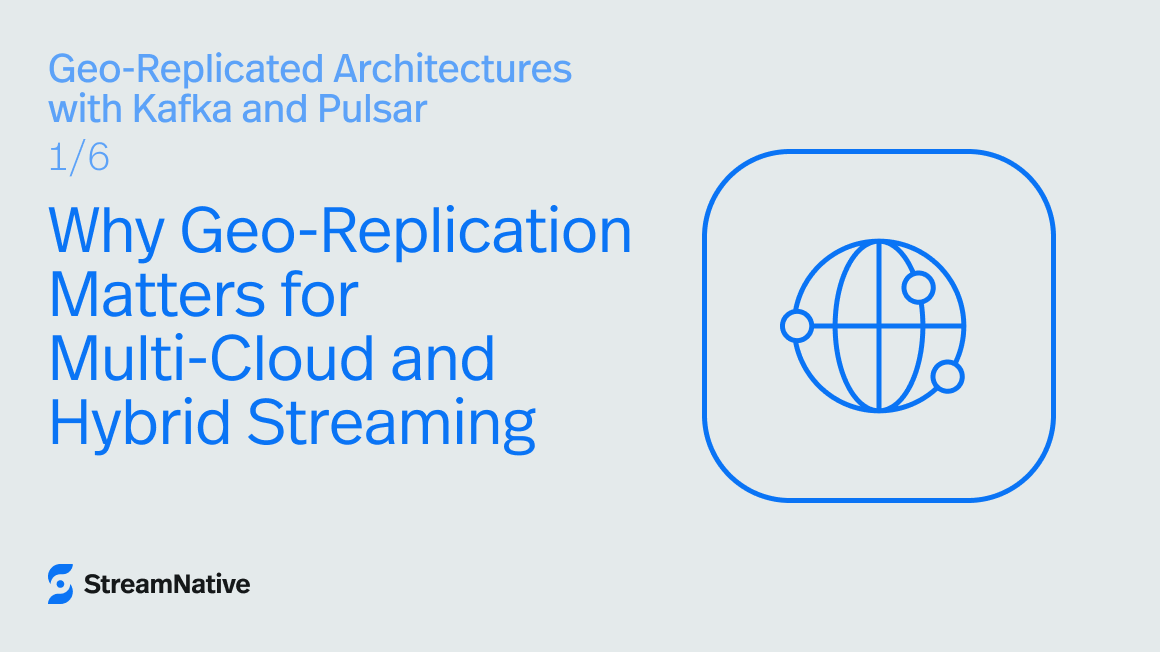Why Geo-Replication Matters for Multi-Cloud and Hybrid Streaming (Geo-Replicated Architectures with Kafka and Pulsar 1/6)

TL;DR
- Geo-replication is the practice of copying streaming data across multiple regions or cloud environments in real time. It underpins disaster recovery (DR), high availability (HA), and low-latency local access in modern data architectures.
- In multi-region, multi-cloud, and hybrid-cloud deployments, geo-replication ensures your streaming platform continues running despite regional outages. It keeps data redundant and consistent across data centers, enabling failover without data loss.
- Geo-replication also improves performance by serving users from the closest region and reducing cross-region traffic. Even if one cloud or data center fails, others have up-to-date data to take over.
- Both Apache Kafka and Apache Pulsar support geo-replication (Kafka via external tools, Pulsar built-in). This series will explore how each approaches it and how to bridge Kafka and Pulsar for a resilient, hybrid streaming ecosystem.
The Need for Geo-Replication in Modern Streaming
Today’s data streaming applications demand global reliability. Whether you’re connecting user activity logs from multiple continents or ensuring an IoT pipeline never goes down, having your data in one place is a risk. Geo-replication – replicating data across geographically distributed clusters – addresses this by keeping multiple copies of data in different locations. If one region experiences a disaster or outage, another region’s cluster can immediately take over with an up-to-date copy of the data. In other words, geo-replication is the linchpin of an effective disaster recovery plan for streaming systems.
High availability goes hand-in-hand with disaster recovery. In a multi-region deployment, even a complete data center outage won’t halt your event streams – consumers and producers can fail over to a healthy region with minimal disruption. For example, a mission-critical Kafka cluster can continue serving applications from a secondary region if the primary region goes down. A geo-replicated Pulsar topic remains available and consistent in surviving regions even if one cluster is offline. The result is near-zero downtime and business continuity for streaming services.
Geo-replication also enables low-latency data access for globally distributed users. By replicating data to multiple geographic regions, you can serve users from the cluster nearest to them, avoiding high latencies of cross-continent data fetches. As an added benefit, this often reduces cloud egress costs and network bottlenecks. Apache Pulsar’s documentation notes that geo-replication provides “low-latency access to data for consumers in different locations,” since data is available in-region rather than halfway around the world. In Apache Kafka ecosystems, it’s common to replicate topics to local clusters on each coast or each continent, so consumers always read from a nearby cluster. In summary, geo-replication brings data closer to your users, improving performance and user experience.
Multi-Region, Multi-Cloud, and Hybrid-Cloud Contexts
Modern architectures increasingly span multiple clouds and on-premises data centers. You might have a streaming pipeline that collects events in your private data center (for compliance reasons) but aggregates and analyzes them in a public cloud. Or, you might deploy clusters in AWS, GCP, and Azure to avoid vendor lock-in. Geo-replication is critical in these scenarios to keep data flowing across heterogeneous environments. It ensures that a message produced in one environment (say, an on-prem Kafka cluster) can be automatically copied to another environment (say, a cloud-based Pulsar cluster) for backup or combined processing.
In hybrid-cloud streaming, where an organization runs streaming platforms both on-premises and in the cloud, geo-replication enables a unified, resilient data fabric. For example, an on-prem Pulsar cluster can continuously replicate topics to a Pulsar cluster in the cloud, providing an off-site backup and feeding cloud-based analytics. Conversely, a cloud Kafka service could replicate to an on-prem Kafka cluster to satisfy data residency requirements or to integrate with local systems. The ability to bridge on-prem and cloud through geo-replication means you can migrate or burst workloads to the cloud without stopping the data flow.
Multi-cloud setups benefit similarly: if you have Kafka clusters in AWS and Azure, setting up geo-replication (through Kafka’s MirrorMaker or Confluent Cluster Linking) between them means each cloud has the full data stream. Users or services in each cloud get local access with minimal latency, and if one cloud has an outage, the other can pick up seamlessly. Geo-replication essentially decouples your streaming availability from any single region or provider’s uptime.
Key Benefits Recap
To summarize the benefits of geo-replication in hybrid streaming:
- Disaster Recovery: By maintaining live copies of data in multiple locations, geo-replication provides strong fault tolerance. If one region or cluster fails due to network outages, power loss, etc., consumers and producers can fail over to a replica in another region with no data loss. Your data streaming applications continue operating even if an entire region goes offline.
- High Availability & Resilience: Even during normal operations, geo-replication keeps your system resilient to localized failures. Individual brokers or entire clusters can be taken down for maintenance or due to incidents, and clients can switch to a healthy cluster. The system remains continuously available, meeting the strict uptime requirements of modern applications.
- Low Latency for Global Users: Geo-replication improves performance by placing data near users. A message produced in Europe can be consumed from a European cluster, one produced in Asia from an Asian cluster, etc., after being replicated. This avoids long WAN round-trips for data access. In Apache Pulsar, for example, producers and consumers can operate in different regions while still achieving low latency, thanks to geo-replication delivering messages to all regions in parallel.
- Data Locality & Compliance: In multi-national operations, you may need data to reside in certain countries or clouds for compliance. Geo-replication lets you funnel specific data streams to specific regions (e.g. replicate only a subset of topics to a European cluster to comply with EU data residency, while keeping full copies in a U.S. cluster). Kafka’s MirrorMaker 2 supports filtering specific topics for replication, allowing data isolation strategies for security/privacy.
- Scalability and Load Balancing: By distributing streaming load across regions, geo-replication can also act as a load-balancing mechanism. Perhaps one region produces the majority of events and another region mostly consumes; replicating data both ways can balance read load. In Kafka, an “active-active” deployment with bidirectional mirroring can enable regional services to produce and consume on their local cluster while exchanging data with other regions as needed. (We’ll discuss the complexity of active-active setups later in the series.)
In short, geo-replication is not just a “nice-to-have” but often a requirement for enterprise streaming systems. It’s what turns a single-region message bus into a globally resilient streaming platform.
Kafka and Pulsar: Different Approaches, Same Goals
Both Apache Kafka and Apache Pulsar recognize the importance of geo-replication, but they implement it in distinct ways. Kafka historically relies on external tools (like MirrorMaker) or add-on features to replicate across clusters, whereas Pulsar builds geo-replication into its core brokers. The next posts in this series will dive into each: we’ll explore Kafka’s approach to multi-region streaming (and the challenges of using MirrorMaker or other techniques), and then Pulsar’s built-in geo-replication and multi-cloud design that make it stand out.
Throughout, we’ll also touch on the reality that many organizations use both Kafka and Pulsar. Perhaps you use Kafka for some legacy systems and Pulsar for new workloads, and you want them to interoperate. We’ll look at cross-platform streaming as a secondary theme – for instance, how to bridge a Kafka pipeline with a Pulsar pipeline in a hybrid cloud. In Part 5, we’ll specifically introduce StreamNative’s UniLink, a tool designed to bridge Kafka and Pulsar streams in a seamless, low-friction way.
By the end of this series, you’ll have a clear understanding of not only why geo-replication is critical for hybrid and multi-cloud streaming, but also how to implement it using Kafka, Pulsar, or a combination of both. You’ll be equipped with an architect’s perspective on designing a resilient, geographically distributed streaming platform.
Key Takeaways
- Geo-replication is essential for disaster recovery and high availability in streaming systems. It keeps your data streaming even if a whole region or cloud goes down.
- By replicating data closer to end users, geo-replication also reduces latency and improves performance for global applications.
- Multi-region and multi-cloud architectures rely on geo-replication to synchronize data across environments – whether on-premises to cloud, or AWS to Azure – ensuring consistency and compliance.
- Apache Kafka and Apache Pulsar both support geo-replication but via different means: Kafka typically uses external tools (MirrorMaker2, etc.), whereas Pulsar has out-of-the-box geo-replication built into the broker layer.
- In hybrid setups that use both Kafka and Pulsar, bridging the two ecosystems is possible (e.g., via connectors or specialized tools like StreamNative UniLink). This allows organizations to leverage the strengths of each in a single resilient platform. Next, we’ll examine Kafka’s native approach to geo-replication in depth.
----------------------------------------------------------------------------------------------
Want to go deeper into real-time data and streaming architectures? Join us at the Data Streaming Summit San Francisco 2025 on September 29–30 at the Grand Hyatt at SFO.
30+ sessions | 4 tracks | Real-world insights from OpenAI, Netflix, LinkedIn, Paypal, Uber, AWS, Google, Motorq, Databricks, Ververica, Confluent & more!
Newsletter
Our strategies and tactics delivered right to your inbox




.png)

.png)
